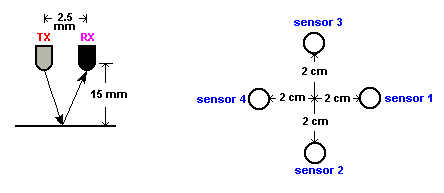#include d:\mc51\8051io.h
#include d:\mc51\8051reg.h
extern register unsigned char speedleft,speedright;
register unsigned char high,low,flag,time;
main()
{
P1=0x40;
P3=0xff;
high = 80;
low = 30;
flag = 0;
time = 50;
Start();
while(1) {
P3|= 0x0f;
Run();
}
}
Start()
{
char exit,key;
exit =1;
while(exit)
{
key = P1;
if((key & 0x40)==0) exit=0;
}
}
Run()
{
char sensors;
sensors = (P3 &=0x0f);
if((sensors & 0x01)==0) {
TurnRight();
flag = 1; }
else if((sensors & 0x08)==0) {
TurnLeft();
flag = 2; }
else if(sensors == 0x09) {
Forward(high);
flag = 0; }
else if(((sensors==0x0b)||(sensors==0x0d))&&(flag==0))
Forward(low);
}
Forward(char speed)
{
P1=0x64;
speedright = speed+10;
speedleft = speed;
delay(time);
}
TurnRight()
{
P1=0x68;
speedright = low+5;
speedleft = low;
delay(time);
}
TurnLeft()
{
P1=0x54;
speedright = low+5;
speedleft = low;
delay(time);
}
Reverse(char speed)
{
P1=0x58;
speedright = speed;
speedleft = speed+5;
delay(time);
}
Asebler :
*#cpu 8051 Tiny
*
* DDS MICRO-C 8031/51 Startup Code & Runtime library for TINY model
*
* Copyright 1991-1999 Dave Dunfield
* All rights reserved.
*
ORG $0000 $0800 CODE Starts here (Normally in ROM)
LJMP START
ORG $0003
LJMP SERVICE_EX0
ORG $000B
LJMP SERVICE_TIMER0_INTERRUPT
* Fixed memory locations for alternate access to the R0-R7 register bank.
* If you are NOT useing BANK 0, these equates must be adjusted.
?R0 EQU 0 Used for "POP" from stack
?R1 EQU ?R0+1 Used to load index indirectly
?R2 EQU ?R0+2 "" "" "" ""
?R3 EQU ?R0+3 Used by some runtime lib functions
?R4 EQU ?R0+4
?R5 EQU ?R0+5
?R6 EQU ?R0+6
?R7 EQU ?R0+7
*
* Startup code entry point
*
* If you are NOT using interrupts, you can reclaim 50 bytes
* of code space by removing the following TWO lines.
* AJMP *+$0032 Skip interrupt vectors
* DS $0032-2 Reserve space for interrupt vectors
*
START EQU *
MOV SP,#?stk-1 Set up initial stack
ORL TMOD,#000001 set timer 0 to be counter 16 bit
SETB IE.7 $AF EA
SETB IE.1 $A9 ET0 Enable timer 0 interrupt
SETB TCON.4 start timer 0
LCALL main Execute program
SJMP * JUMP HERE
* EXIT to MON51 by calling the 'timer1' interrupt vector ($001B).
* This causes MON51 to think that a single-step operation has just
* completed, and therefore it saves the user registers, and performs
* a context switch back to the monitor.
*
* When using 2K addressing (CC51: -Z option, ASM51: -A option) this LCALL
* may fail "Out of range" because it gets translated to ACALL, and $001B
* may not be in the same 2K block as your program. Since 2K devices cannot
* support a debugger, change the ORG to $0000, and ...<continue below>...
*
* If you are NOT using MON51 (or MONICA which works the same), you will
* need to change this to whatever action you desire when main() returns.
* Suggestions: 1:freeze (SJMP *) 2:Restart (SJMP *&$FF00)
exit LCALL $001B Call Timer-1 interrupt
SJMP exit Incase he go's again
==============assembly code============================
SERVICE_TIMER0_INTERRUPT EQU *
PUSH ACC
PUSH PSW
MOV TH0,#$FF reload timer 0 for ms
MOV TL0,#$00
INC tick
MOV A,tick
CJNE A,#100,RIGHT
MOV tick,#0
RIGHT
CLR C
SUBB A,speedright
JC ON_RIGHT
CLR P1.0
SJMP LEFT
ON_RIGHT
SETB P1.0
LEFT
MOV A,tick
CLR C
SUBB A,speedleft
JC ON_LEFT
CLR P1.1
SJMP EXIT_I
ON_LEFT
SETB P1.1
EXIT_I
POP PSW
POP ACC
RETI
SERVICE_EX0 EQU *
INC cputick
RETI
$SE:1
*#map1 Segment 1, initialized variables
$SE:2
*#map2 Segment 2, internal "register" variables
ORG $0008 Internal ram ALWAYS starts here
tick DS 1
speedright DS 1
speedleft DS 1
cputick DS 1











No comments:
Post a Comment